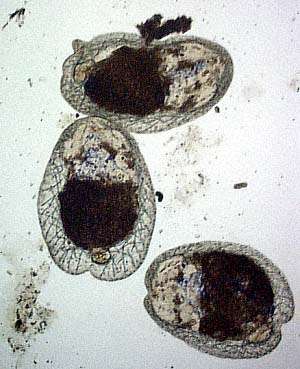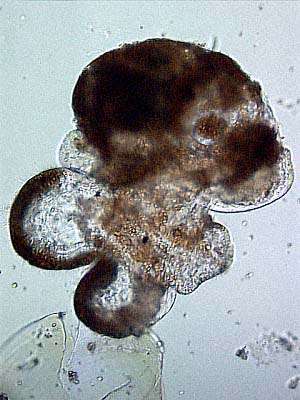Hypselodoris zebra larvae from Bermuda
February 18, 1999
From: J.E. Austin

Last November, I wrote in concerning raising Hypselodoris zebra egg ribbons to hatching. I placed the egg ribbons in sea water (fresh from the reach off of the Bermuda Biological Station) changed daily. Ribbons were suspended in a cupped patch of plankton netting which was itself placed inside the cut open bottom of a 2 liter coke bottle turned upside down. At the mouth of the bottle was placed a cork with a tube inserted. The tube connected to an air pump. I changed the water daily by lifting up the plankton netting, transferring to a beaker and then switching the water. After maybe 3 wks., the eggs hatched into veliger larvae. They have cool patchs of purple presumably from internal food stores of the animals food source, the sponge Dysidea. Then the larvae became these little crawling beanie caps. Sorry for my inexpertise with sea slug life stages, but further description for any of my appended photos would be appreciated.
Sorry for taking so long to post these puppies. But the midnight when I discovered that they had hatched, I rounded up a poor graduate student to help me photograph them. Sea slugs are a driving inspiration.
J.E. Austin
Florida State University
jaustin@bio.fsu.edu


Dear Austin,
What great photos! It was certainly worthwhile you taking up my idea of seeing if you could get the eggs to develop. Your photos show that Hypselodoris zebra has lecithotrophic larvae. Lecithotrophic larvae are relatively short-lived non-feeding swimming veligers which metamorphose into crawling juveniles after a period in the plankton. In some cases the lecithotrophic veliger can spend only a few minutes or hours before settling, in other species they last for a few days before settling. Have you any idea how long the veligers spent swimming before settling?
Your photos show (bottom left) a veliger which apparently has cast its shell and is about to settle down to benthic living. The black-edged lobes you can see are the reduced lobes of the velum - which with a band of beating cilia along the edge, are the veliger's swimming organ. In the photo (bottom right) of a metamorphosed juvenile, I have labelled some of the organs. I have never seen larvae with the brightly coloured pigmentation these ones do. The bluish purple region seems to include the buccal bulb and the nerve ganglia which cluster around the oesophagus just behind the buccal bulb and form its "brain".
The network of "spicules" form a structural network in the mantle tissue which is maintained in many dorid adults but is lost in most chromodorids. You have caught the larvae at such an early stage in their development that there does not seem to be any sign of rhinophore buds, and the larval kidney is still present. The otocysts are balance organs.
I am interested in the purple colouration. Did these animals have access to the sponge, Dysidea, on which the adults feed? If they did not, it suggests they carry pigment through from the egg - an interesting thought.
Thanks again Austin for sharing this interesting observation with us. It only goes to show that there are lots of valuable observations that can be made quite easily. One of the aims of the Forum is to publish such information. To me, and I presume to other researchers, such observations help to fill the many gaps in our knowledge. In themselves such observations usually are never published because they are too insignificant for a journal editor to bother with, or not "rigorous" enough for a scientific reviewer. To me they are all important pieces in a puzzle and I am happy to share them via the Forum.
Best wishes,
Bill Rudman.
Related messages
-
Hypselodoris zebra - old reference and new photo
From: Thaddeus Murdoch, February 18, 2010 -
Photos of Hypselodoris zebra & eggs
From: Daniel Geiger, March 12, 1999 -
Re: Hypselodoris zebra larvae
From: Bill Rudman, February 26, 1999 -
Re: Hypselodoris zebra larvae from Bermuda
From: J.E. Austin, February 20, 1999 -
re: Sea Slug Forum
From: J.E.Austin, November 11, 1998 -
Re: J.E.Austin's Hypselodoris zebra query
From: Bill Rudman, November 9, 1998
